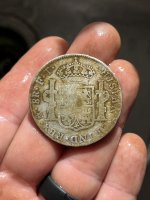kenb
Bronze Member
Superstitions rich in lore, if not ore
John Stanley
The Arizona Republic
Oct. 15, 2007 12:00 AM
The 160,000-acre Superstition Wilderness in the East Valley contains some of the best hiking country in Arizona. Stretching 24 miles from east to west and about half that from north to south, the wilderness has everything from stark, rocky peaks to rolling, pine-covered hills; narrow canyons to open desert plateaus.
Its more than 180 miles of interconnecting trails make it easy to plan anything from a three-hour day hike to a weeklong backpack.
No trip to the Superstition Mountains would be complete without retelling the tales of hidden treasure, crazy hermits and Indian massacres. advertisement
Chief among the mysteries of the Superstitions is the story of the Lost Dutchman Mine, among the most famous and enduring stories in Old West lore.
The story goes like this: During the first half of the 19th century, the Peralta family of Mexico worked several rich mines in what is now Arizona. After the Mexican War, the family worked frantically to extract as much ore as possible before the international border shifted south, leaving their holdings in U.S. territory.
One last expedition, its wagons laden with gold ore, was on its way to Mexico when Apaches attacked, slaughtering the miners in a battle that lasted for days across the northwestern flanks of the Superstitions, an area known today as the Massacre Grounds.
Lending credence to the Peralta massacre story is a report that in 1912, prospectors Carl Silverlocke and Carl Malm found about $18,000 worth of gold ore in the area where the massacre allegedly took place.
Survivor's story
Only one member of the Peralta expedition survived the attack and made it home to Mexico. Decades later, he revealed the location of the richest of the family's mines to Jacob Waltz, who had saved the life of another family member.
The story, true or not, is based on a few nuggets of fact: A Jacob Waltz was born in 1808 in Germany - the word "Dutch" commonly was used in the 19th century to describe those from Germany, as well as those from the Netherlands - and came to the United States in 1846. He found work as a miner, first in North Carolina, then in Georgia.
Like many fortune seekers of that era, Waltz made his way to California, where he became a naturalized citizen in 1861. Three years later, he was in Arizona Territory, living in the Walker mining district near Prescott. In 1868, he homesteaded 160 acres near the Salt River in what is now the East Valley. He died there, in poverty, in 1891.
Now back to rumor, speculation and hearsay: On his deathbed, Waltz supposedly told his caretakers, Julia Thomas and Rhinehart Petrasch, about a fabulously rich mine he had discovered in the Superstitions. After his death, a few pieces of rich gold ore were found in a box under his bed.
The story has several subvariations. Some say Waltz and his partner, Jacob Wiser, worked a mine they stumbled upon in the mountains. Some say Waltz killed Wiser, perhaps by accident, perhaps not. Others say Apaches killed Wiser.
Somehow Waltz ended up as sole owner of the mine. But fearful that other prospectors might overpower him and steal his ore, and confident that the mine's concealed location would keep it safe, he never recorded a claim.
Other stories say that instead of a mine, Waltz came across a cache of gold ore that the Peralta expedition had dumped and hidden as it fled the Apache attack.
Still other stories say the only gold Waltz ever had were a few nuggets he had stolen when he worked at the Vulture Mine in Wickenburg.
Deadly quest
Although geologists almost universally dismiss the idea of gold-bearing ore in the Superstitions, countless adventurers over the years have sought the mine. More than two dozen of the seekers have lost their lives in the process.
In addition to miners, the Superstitions have been home to a number of eccentrics over the years.
The most noted was Elisha Reavis, the scraggly bearded "hermit of the Superstitions," who, in 1874, made a farm along a creek in the eastern Superstitions, where he grew vegetables to sell in the Valley.
Some folks thought Reavis was crazy. Others said he pretended to be insane so Apaches and White men would leave him alone.
Reavis died in 1896. His grave site, marked by a crude pile of rocks, lies just a few yards off a popular trail.
kenb
John Stanley
The Arizona Republic
Oct. 15, 2007 12:00 AM
The 160,000-acre Superstition Wilderness in the East Valley contains some of the best hiking country in Arizona. Stretching 24 miles from east to west and about half that from north to south, the wilderness has everything from stark, rocky peaks to rolling, pine-covered hills; narrow canyons to open desert plateaus.
Its more than 180 miles of interconnecting trails make it easy to plan anything from a three-hour day hike to a weeklong backpack.
No trip to the Superstition Mountains would be complete without retelling the tales of hidden treasure, crazy hermits and Indian massacres. advertisement
Chief among the mysteries of the Superstitions is the story of the Lost Dutchman Mine, among the most famous and enduring stories in Old West lore.
The story goes like this: During the first half of the 19th century, the Peralta family of Mexico worked several rich mines in what is now Arizona. After the Mexican War, the family worked frantically to extract as much ore as possible before the international border shifted south, leaving their holdings in U.S. territory.
One last expedition, its wagons laden with gold ore, was on its way to Mexico when Apaches attacked, slaughtering the miners in a battle that lasted for days across the northwestern flanks of the Superstitions, an area known today as the Massacre Grounds.
Lending credence to the Peralta massacre story is a report that in 1912, prospectors Carl Silverlocke and Carl Malm found about $18,000 worth of gold ore in the area where the massacre allegedly took place.
Survivor's story
Only one member of the Peralta expedition survived the attack and made it home to Mexico. Decades later, he revealed the location of the richest of the family's mines to Jacob Waltz, who had saved the life of another family member.
The story, true or not, is based on a few nuggets of fact: A Jacob Waltz was born in 1808 in Germany - the word "Dutch" commonly was used in the 19th century to describe those from Germany, as well as those from the Netherlands - and came to the United States in 1846. He found work as a miner, first in North Carolina, then in Georgia.
Like many fortune seekers of that era, Waltz made his way to California, where he became a naturalized citizen in 1861. Three years later, he was in Arizona Territory, living in the Walker mining district near Prescott. In 1868, he homesteaded 160 acres near the Salt River in what is now the East Valley. He died there, in poverty, in 1891.
Now back to rumor, speculation and hearsay: On his deathbed, Waltz supposedly told his caretakers, Julia Thomas and Rhinehart Petrasch, about a fabulously rich mine he had discovered in the Superstitions. After his death, a few pieces of rich gold ore were found in a box under his bed.
The story has several subvariations. Some say Waltz and his partner, Jacob Wiser, worked a mine they stumbled upon in the mountains. Some say Waltz killed Wiser, perhaps by accident, perhaps not. Others say Apaches killed Wiser.
Somehow Waltz ended up as sole owner of the mine. But fearful that other prospectors might overpower him and steal his ore, and confident that the mine's concealed location would keep it safe, he never recorded a claim.
Other stories say that instead of a mine, Waltz came across a cache of gold ore that the Peralta expedition had dumped and hidden as it fled the Apache attack.
Still other stories say the only gold Waltz ever had were a few nuggets he had stolen when he worked at the Vulture Mine in Wickenburg.
Deadly quest
Although geologists almost universally dismiss the idea of gold-bearing ore in the Superstitions, countless adventurers over the years have sought the mine. More than two dozen of the seekers have lost their lives in the process.
In addition to miners, the Superstitions have been home to a number of eccentrics over the years.
The most noted was Elisha Reavis, the scraggly bearded "hermit of the Superstitions," who, in 1874, made a farm along a creek in the eastern Superstitions, where he grew vegetables to sell in the Valley.
Some folks thought Reavis was crazy. Others said he pretended to be insane so Apaches and White men would leave him alone.
Reavis died in 1896. His grave site, marked by a crude pile of rocks, lies just a few yards off a popular trail.
kenb






